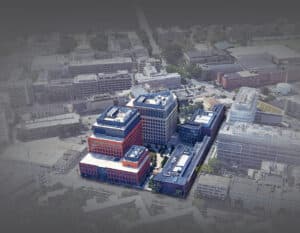
In the past year’s biggest life science transaction in Greater Boston, Bulfinch Cos. and Harrison Street acquired the 677,000-square-foot Osborn Triangle in Cambridge for $1.1 billion. Image courtesy of CBRE.
With a combination of low vacancy, high demand and some of the highest asking rents in the country, life science properties in the Boston metro are more desirable than ever for investment firms, both large and small.
Across Boston, Cambridge and the suburbs, life science vacancy is 4.1 percent with East Cambridge, the second largest life science cluster in the country, at a 2 percent.
With 30 million square feet of life science space spanning 200 properties across the entire metro area, national REITs and regional private investors are looking to capitalize on the booming sector. During 2019, the Boston market saw nearly $3.3 billion of investment sales in life science properties as well as proposed developments with lab capabilities, per Real Capital Analytics. The demand from life science firms remains very strong, as the Cambridge and Boston markets continue to be the epicenter of the industry.
5M SF in Seaport Pipeline
The Seaport District is evolving quickly as a relief valve to supplement the demand for life science market in Cambridge with both developers and landlords flocking to the area.
Related Beal plans to construct over 1 million square feet, including two lab buildings at an old Gillette parking lot purchased earlier this year for $218 million. Alexandria Real Estate Equities acquired two properties this year and is in the process of planning a 650,000-square-foot campus with plenty of lab space. ARE purchased a total of 2.7 acres at 5 and 15 Necco St. in the Seaport for $252 million and a parking garage at 10 Necco St. for $81 million.
Oxford Properties also made their first foray into the life science asset class by purchasing Pappas Enterprises’ 655 Summer St. and the surrounding land. Oxford is planning to turn the industrial property into a life science building.
The Seaport has nearly 5 million square feet of proposed or under construction developments that will incorporate life science space.
The Seaport has nearly 5 million square feet of proposed or under construction developments that will incorporate life science space. With speed to occupancy a priority, expect to see tenants willing to sign several months before delivery of on spec developments.
90 Firms Need Lab Space
In the suburban markets surrounding Boston and Cambridge, strong volume among life science assets with a healthy construction pipeline for future life science developments led investment activity.

Suzanne Duca
Sanofi Genzyme’s sale of their Waltham portfolio, which consisted of two properties totaling 140,000 square feet, to West Coast investment firm Montana Avenue Capital Partners shows the interest of outside investors in the lab asset class. Sanofi and Montana Avenue entered into a sale-leaseback agreement, where Sanofi will continue to occupy the properties into 2022. More life science tenants have migrated out of Cambridge this year to the suburbs than any year in the past. Watertown, Waltham and Lexington provide state-of-the-art facilities like Cambridge but at a significant discount.
The largest transaction of 2019 was the sale of the Osborn Triangle, three class A lab buildings totaling 677,000 square feet, which sold for $1.1 billion to a partnership between Harrison Street and Bulfinch Cos. The Davis Cos. developed 35 Cambridge Park Drive in West Cambridge and the speculative building was
sold, 100 percent leased, late this year. Historically, East Cambridge has one of the lowest vacancies across the country and one of the highest asking rents – $99.37 per square foot triple-net – with the proximity to the highly educated workforces at Harvard University and the Massachusetts Institute of Technology making it desirable for investors who have the capital.

Connor Channell
The demand for lab space is not slowing, whether it is tenants looking to expand their presence, or new tenants looking to get into the market. There are nearly 90 companies who are looking for over 3 million square feet of lab space across Boston, Cambridge and the suburbs. With a limited number of assets trading in the heart of East Cambridge, suburbs like Watertown and Waltham are expected to see a significant number of investors getting into this hot asset class.
Suzanne Duca is director of research, New England and Connor Channell is senior research analyst for CBRE.





